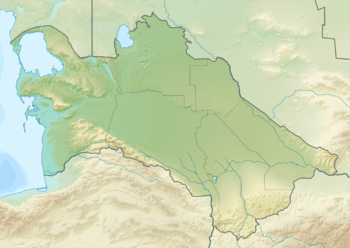Namazga-Tepe
Namazga-Tepe or Namazga-depe, is a Bronze Age (BMAC) archaeological site in Turkmenistan, some 100 km from Aşgabat, near the border to Iran. Excavated by Vadim Mikhailovich Masson, Viktor Sarianidi, and I. N. Khlopin from the 1950s, the site set the chronology for the Bronze Age sites in Turkmenistan (Namazga III-VI).
 Location in Turkmenistan | |
| Alternative name | Namazga-depe |
|---|---|
| History | |
| Periods | Bronze Age |
| Cultures | BMAC |
Namazga culture was preceded in the area by Jeitun culture.
Chronology
It is believed that Anau culture of Turkmenia considerably precedes the Namazga culture in the area. Namazga I period (c. 4000–3500 BC),[1] is considered contemporary with Anau IB2 period.
Namazga III (c. 3200-2800) as a village settlement in Late Chalcolithic phase, and Namazga IV (c. 2800–2400 BC) as a proto-urban site, both belong to the Late Regionalization Era.[1]
Namazga V (c. 2400–2000 BC),[1] is in the Integration Era or the period of "urban revolution" following the Anatolian model with little or no irrigation. Namazga-Tepe emerges as the production and probable governmental center, covering some 60 hectares, with Altyndepe likely a secondary capital. Around 1600 BC, Altyndepe is abandoned, and Namazga-Tepe shrinks to a fraction of its former size.
Namazga VI in the Late Bronze Age (c. 1800–1500 BC),[1] as part of the Localization Era is characterized by the incursion of nomadic pastoralists from the Alekseyevka culture and/or Srubna culture.
There have also been detailed painted potteries located at this site.[2]
The following table clarifies the chronology of Namazga culture.
| Period | Dates |
|---|---|
| Neolithic of Jeitun type | 6200–5000 BCE |
| Proto-Chalcolithic (Anau Ia) | 5200–4800 BCE |
| Early-Chalcolithic (Namazga I) | 4800–4000 BCE |
| Middle-Chalcolithic (Namazga II) | 4000–3500 BCE |
| Late-Chalcolithic (Namazga III) | 3500–3000 BCE |
| Early Bronze (Namazga IV) | 3000–2500 BCE |
| Middle Bronze (Namazga V) | 2500–2200 BCE |
| Late Bronze (Namazga VI) | 2200–1500 BCE |
| Late Bronze (Margian, Gonur phase) | 2200–1800 BCE |
| Late Bronze (Margian, Togolok phase) | 1800–1500 BCE |
| Early Iron (Yaz I) | 1500–1100 BCE |
| Archaic Dehistan (SW Turkmenistan) | 1300–500 BCE |
| Pre-Achaemenid and Achaemenid (Yaz II-III) | 1100–329 BCE |
References
- Vidale, Massimo, (2017). Treasures from the Oxus., p. 9, Table 1.
- Langer, William L., ed. (1972). An Encyclopedia of World History (5th ed.). Boston, MA: Houghton Mifflin Company. p. 17. ISBN 0-395-13592-3.
- Lecomte, Olivier, (2011)."Ulug-depe: 4000 Years of Evolution between Plain and Desert", in Historical and Cultural Sites of Turkmenistan, p. 223.
Bibliography
- V. M. Masson and V. I. Sarianidi, Central Asia: Turkmenia before the Achaemenids (trans. Tringham, 1972); review: Charles C. Kolb, American Anthropologist (1973), 1945-1948.
External links
- Altin Tepe entry in Encyclopaedia Iranica